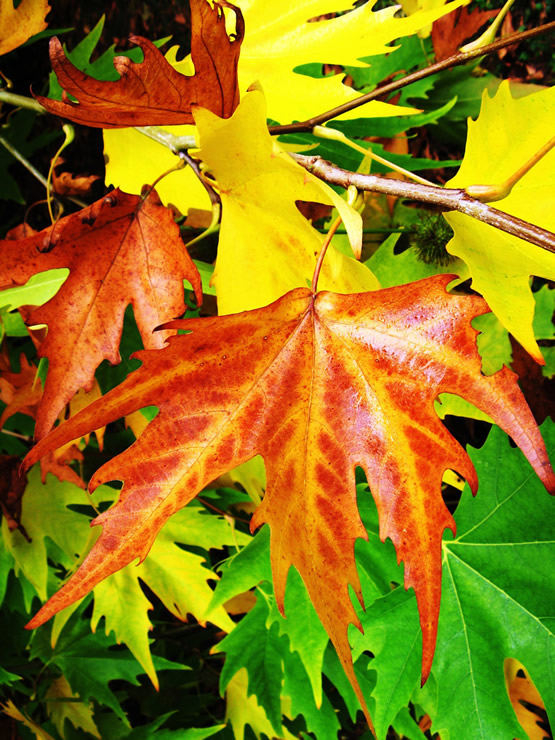 |
| Pigments in plants |
Photosynthetic pigments color plants and participate in photosynthesis. Other plant pigments are important in flowers and fruits to attract pollinators and seed dispersers. Humans use plant pigments in vitamins and dyes.
Plant pigments can be classified as either nitrogenous or non-nitrogenous, that is, either nitrogen-containing or non-nitrogen-containing.
Non-nitrogenous pigments
Non-nitrogenous forms are widely distributed and include the carotenoids and the quinones. Carotenoids are yellow, orange, or red pigments often involved as accessory pigments in photosynthesis. They are insoluble in water but soluble in a variety of nonpolar solvents. They are easily bleached by light or oxygen.
  |
Carotenoids occur as hydrocarbon carotenes and oxygenated xanthophylls. They are made by bacteria, fungi, algae, and other plants. Variations of their occurrence and their multiplicity make carotenoids useful in taxonomic differentiation of these organisms.
The quinones include benzoquinones, naphthoquinones, and anthraquinones. Benzoquinones occur in fungi and higher plants as yellow, orange, red, or violet pigments. Yellow coenzyme Q variants (ubiquinones) and plastoquinones are found in most plants. Because of their low tissue levels, they do not affect plant color.
Naphthoquinones of bacteria and leaves, seeds, and woody parts of higher plants have yellow, orange, red, or purple pigments, soluble in nonpolar solvents. A familiar example is vitamin K. Brightly colored anthraquinones also occur in many plants.
Many other complex plant quinones are water-soluble flavonoids, all containing a common fifteen-carbon skeleton, flavone (2-phenylben-zopyrone). The various flavonoids differ in how many hydroxyl or methoxyl groups they contain.
They occur as sugar-containing substances called glycosides, which is the basis of their water solubility. The members of one plentiful group of flavonoids are the anthoxanthins, which are yellow pigments. Another important flavonoid group, anthocyanins, are orange, red, crimson, or blue.
Nitrogenous Pigments
The nitrogenous (nitrogen-containing) pigments are tetrapyrrole porphyrins and their derivatives, indigoids and flavins. The porphyrins are water-soluble, cyclic, nitrogen-containing substances.
The basic structural unit of all porphyrins is a large tetrapyrrole ring made up of four smaller connected pyrrole rings. Porphyrins combine with metal ions and proteins. In plants they are represented by green chlorophylls.
 |
| tetrapyrrole ring system |
The chlorophylls contain magnesium ions and are associated with water-insoluble proteins. Related bilins are a group of yellow, green, red, or brown compounds that have linear structures composed of four connected pyrrole rings.
The bilins include red bilirubin, green biliverdin, and the phycobilins of red algae or green plants. Examples are blue phycocyanobilin and phytochrome as well as red phycoerythrin. Plant bilins bind water-soluble and water-insoluble proteins.
Indigoids, a group of indole pigments, derive from the amino acid tryptophan. They are red, blue, or purple. The flavins (lyochromes) are pale yellow, water-soluble pigments widely distributed in plants. The most plentiful flavin is riboflavin (vitamin B2). Flavins are made by bacteria, yeasts, and green plants.
   |
Functions
Non-nitrogenous benzoquinones and ubiquinones are involved in electron transport processes important in respiration. Naphthoquinones have similar functions in photosynthesis and are also represented by K vitamins.
Anthroquinones are the brilliantly colored compounds seen in the colors of flowers. Similarly, flavonoid glycosides color many flowers. For example, the anthoxanthins produce the yellow color of buttercups.
Anthocyanins make flower petals orange-red, crimson, and blue. They cause much of the red color seen in some plant buds and shoots, the colors of autumn leaves, fruits (such as berries), or roots (such as beets).
Atypical anthocyanin is red in acid solution, violet in neutral solution, and blue in alkaline solution. Blue or red cornflowers and violet dahlias contain the same anthocyanin, their color differences simply being the result of pH(acidity or alkalinity) differences of the cell sap.
The function of flavonoids is still unclear. However, it is believed that they are essential in flowers for attracting bees and other pollinators, encouraging cross-pollination. They are also thought to attract larger animals to bright-colored, edible fruits, enhancing seed dissemination, and to protect plants from damage by ultraviolet light.
Nitrogen-containing tetrapyrrole plant porphyrins are best known because of the key role they play in photosynthesis. Chlorophylls enable photosynthetic conversion of sunlight to chemical energy, which is used by plant cells to use carbon dioxide to make organic molecules.
Chlorophylls include chlorophylls a and b of higher plants and green algae and the bacteriochlorophylls in photosynthetic bacteria. The various chlorophylls differ in onlyminorways as a result of side chain groups attached to their pyrroles.
In higher plants, chlorophylls bind to proteins and lipids in the thylakoid membranes of chloroplasts, where they function in photosynthesis. Some of the phycobilins of blue algae, red algae, and green plants act as accessory photosynthetic pigments. Another function of bilins is as phytochromes, essential to photoperiodic processes.
Economic Uses
Many plant pigments meet human nutritional needs. The carotenes, derived from carotenoids, are used in the biosynthesis of vitamin A, essential to vision and growth.
Furthermore, napthoquinone photosynthetic pigments lead to another important vitamin group: K vitamins, essential to blood clotting. Yet another vitamin derived from plant pigments is a nitrogen-containing flavin called riboflavin, better known as vitamin B2.
Many plant pigments are used as dyes or as model compounds from which other dyes have been synthesized. The naphthoquinones from leaves, seeds, and woody parts of higher plants are isolated as yellow, orange, red, or purple materials soluble in organic solvents and used as fabric dyes.
Indigo, a blue indigoid which occurs in many plants of Asia, Africa, and South America, has been used as a blue dye and the model for many industrially synthesized dyes. Similarly, anthraquinones, brightly colored plant pigments, are widely used.
Moreover, because their colors change in acidic, basic, and neutral solutions, anthraquinones are used as acid-base indicators. Flavonoid anthocyanins (as was mentioned) are also used as acid-base indicators. A variety of edible plant pigments are also used to add color to foods.